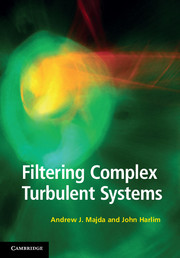1 - Introduction and overview: Mathematical strategies for filtering turbulent systems
Published online by Cambridge University Press: 05 March 2012
Summary
Filtering is the process of obtaining the best statistical estimate of a natural system from partial observations of the true signal from nature. In many contemporary applications in science and engineering, real-time filtering of a turbulent signal from nature involving many degrees of freedom is needed to make accurate predictions of the future state. This is obviously a problem with significant practical impact. Important contemporary examples involve the real-time filtering and prediction of weather and climate as well as the spread of hazardous plumes or pollutants. Thus, an important emerging scientific issue is the real-time filtering through observations of noisy signals for turbulent nonlinear dynamical systems as well as the statistical accuracy of spatio-temporal discretizations for filtering such systems. From the practical standpoint, the demand for operationally practical filtering methods escalates as the model resolution is significantly increased. In the coupled atmosphere–ocean system, the current practical models for prediction of both weather and climate involve general circulation models where the physical equations for these extremely complex flows are discretized in space and time and the effects of unresolved processes are parametrized according to various recipes; the result of this process involves a model for the prediction of weather and climate from partial observations of an extremely unstable, chaotic dynamical system with several billion degrees of freedom. These problems typically have many spatio-temporal scales, rough turbulent energy spectra in the solutions near the mesh scale, and a very large-dimensional state space, yet real-time predictions are needed.
- Type
- Chapter
- Information
- Filtering Complex Turbulent Systems , pp. 1 - 12Publisher: Cambridge University PressPrint publication year: 2012



